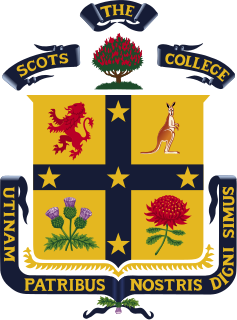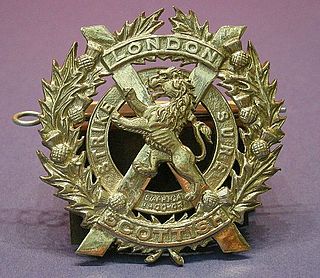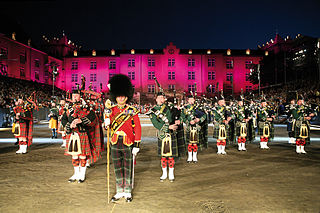
A pipe band is a musical ensemble consisting of pipers and drummers. The term pipes and drums, used by military pipe bands is also common.

The Royal Edinburgh Military Tattoo is an annual series of military tattoos performed by British Armed Forces, Commonwealth and international military bands, and artistic performance teams on the Esplanade of Edinburgh Castle in the capital of Scotland. The event is held each August as one of the Edinburgh Festivals.

The Gonnema Regiment is a reserve mechanised infantry regiment of the South African Army.

The Scots College is a multi-campus independent Presbyterian single-sex primary and secondary day and boarding school for boys, predominantly located in Bellevue Hill, an eastern suburb of Sydney, New South Wales, Australia.

The London Scottish was a reserve infantry regiment then a company of the British Army. In its final incarnation it was A Company, the London Regiment until, on 1 May 2022, soldiers in the company transferred to foot guards regiments and the company became G (Messines) Company, Scots Guards, 1st Battalion London Guards.
The Army School of Bagpipe Music and Highland Drumming is a British Army training establishment that provides instruction on Scottish pipe band music to military pipers and drummers.

A military tattoo is a performance of music or display of armed forces in general. The term comes from the early 17th-century Dutch phrase doe den tap toe, a signal sounded by drummers or trumpeters to instruct innkeepers near military garrisons to stop serving beer and for soldiers to return to their barracks and is unrelated to the Tahitian origins of an ink tattoo.
Alex Duthart was a Scottish drummer. He is widely regarded as having revolutionised pipe band snare drum playing.
The Scots School Albury is an independent, K-12, Uniting Church, co-educational day and boarding School, located in Albury, New South Wales, Australia. It draws students from the local area and other parts of Australia.

Top Secret Drum Corps is a drum corps based in Basel, Switzerland. With 25 drummers and colour guard section, the corps became famous for its demanding six-minute routine performed at the Royal Edinburgh Military Tattoo in 2003. With its invitation to Edinburgh, Top Secret became one of the first non-military, non-British Commonwealth acts to perform on the Esplanade at Edinburgh Castle.
Roderick 'Roddy' (R.S.) MacDonald is a pipe major, living in Brisbane, Australia, and a composer of tunes for the bagpipes.

The Regimental Pipes and Drums of The Calgary Highlanders is an authorized volunteer pipe band associated with The Calgary Highlanders of the Canadian Forces. For many years, the band was a bona fide, and separate, military unit unto itself, with a separate Unit Identification Code within the CF. Today, the band has been reduced to volunteer status but officially maintains an establishment of eight paid military musicians on its rolls. The band has had mixed success in competitions, but under the direction of Pipe Major Michael Giles had become successful in the Grade Three circuit in Alberta in the years leading up to the regimental centennial in 2010. The band published a recording to commemorate the 80th anniversary of the Regiment in 1990, titled Eighty Years of Glory and commemorated its centennial in 2010 by releasing a second CD entitled Onward.
The Regimental Band and Pipes was founded on The Citadel campus in Charleston, South Carolina in 1909 with late marine general, Harry K. Pickett, in command. The marching band makes up one of the twenty-one companies of the South Carolina Corps of Cadets. In 1991, the band participated in the Edinburgh Military Tattoo in Edinburgh, Scotland becoming the first military college selected for the honor. They returned in 2010 as the only unit from the United States to appear at the Silver Jubilee of the Tattoo and appeared again in 2015.
The Scottish Pipe Band Association of South America (SPBASA), is the pipe band association currently comprising Argentina, Brazil, Chile and Uruguay. It approved its first constitution on December 20, 2003 in Buenos Aires, Argentina; and was officially inaugurated on April 17, 2004 at the First South American Pipe Band Gathering in Montevideo, Uruguay. The comparatively low number of pipe bands and the number of countries encompassed are the principal reasons behind this pipe band association being so unique.
Adelaide Universities Regiment (AUR) is an officer training unit of the Australian Army headquartered in Adelaide, South Australia. Currently AUR maintains a cadre staff of trained Regular and Reserve personnel who oversee and administer the training of Reserve officer cadets. The majority of the regiment is currently based at Hampstead Barracks.

Canadian military bands are a group of personnel in the Canadian Armed Forces (CAF) that performs musical duties for military functions. Military bands form a part of the Music Branch of the CAF, composed of six full-time professional Regular Force bands, 15 Regular Force voluntary bands, and 53 part-time reserve force bands. Bands of the Music Branch are often badged with the unit or Canadian Forces base insignia that they support.

Basel Tattoo is an annual military tattoo show performed by International military bands, display teams, popular musicians, and tattoo formations in Basel, Switzerland.

The Brazilian Marine Pipes, Drum and Bugle Corps is the only field music formation in service in the Brazilian Marine Corps and within the wider Brazilian Navy, and one of a few active formations today in service in the Brazilian Armed Forces. Formed in 1822 on the basis of the field music formations of the present day Portuguese Marine Corps stationed in Brazil, it is also the oldest in South America.

There are currently 9 main military bands currently belonging to the South African National Defence Force (SANDF), which represent the different branches of the SANDF and providing music on ceremonial occasions. Since military bands were introduced in the country, they have played a prominent role in public and military life. Pipe bands also play an important role in South African military music, with notable pipe bands coming from the Transvaal Scottish Regiment and the South African Military Health Service. Military bands of the SANDF are also affiliated with the police bands of the South African Police Service. In addition to military music, military bands in the SANDF perform different genres, including classical, jazz, pop and light music.

The Omani Royal Guard Military Band is the official music band of the Royal Guard of Oman and the seniormost military band of the Sultan of Oman's Armed Forces. It is specifically dedicated to providing ceremonial honours and music to the Sultan of Oman, the House of Al Said, and public officials.













